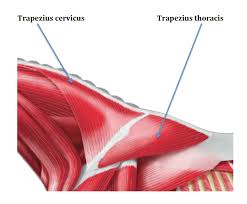How to achieve a “soft back”
April 14, 2014 by
We always hear coaches talking about getting our horses to soften and use their backs. There are several sections of the back that the horse can resist from but today we are going to discuss how and why we need access to the base of the neck. It is very important to have this section of the topline soft because without this key section being relaxed the horse can neither lift its shoulders nor connect to its lower back.
The group of muscles that I am talking about are illustrated in the picture below. This triangular group of muscles, when trained properly should appear to reach from the top of the withers and line of the shoulder, all the way up the neck to behind the ears. It should not be fat or thick at the base of the neck. If it is, the horse is holding his neck by pulling it backwards into the shoulder. The correct feeling of the base of the neck being soft can be described as the feeling of the neck “draping” from the withers without resistance.
The horses should reach down and out with its nose and look for the contact, when you have achieved the correct position. This feeling can be obtained through the use of bend, paying particular attention to the way the horse bends its neck where it comes out of the shoulder. To break the initial tension in that area, imagine that when you bend the horse’s neck left, the shoulders will fall out to the right and vice versa.
By removing the tension from the base of the neck, the rider is also in most cases taking tension out of the horse’s lower back. A horse should balance itself through long, relaxed topline muscles. Often the idea of collecting a horse makes the rider think they need to contract the horse’s muscles. This is not the case. Collection should always be achieved through relaxation. Many riders will also endeavour to stretch their horse’s but without ensuring the muscles in front of the withers are soft and long, the exercise is wasted. The same is true for a horse that is low and appearing to stretch but behind the vertical. If the horse’s nose is not open when it is stretching, it will not gain the strength required in the lower back for the higher levels. Obtaining this feeling will allow you to lift the frame through the whole topline, not just bring the neck up leaving the shoulders and back down.
*Please read my article on Toe Flicking to help you understand some of the symptoms of an incorrect connection over the topline.